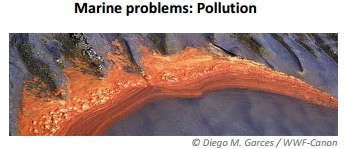A expressão sublinhada em “These animals are in turn eaten ...
Próximas questões
Com base no mesmo assunto
Ano: 2014
Banca:
BIO-RIO
Órgão:
ETAM
Prova:
BIO-RIO - 2014 - ETAM - Curso de Formação de Técnicos - 1ª Semestre de 2015 |
Q508829
Inglês
Texto associado

Almost every marine organism, from the tiniest plankton to whales and polar bears, is contaminated with man-made chemicals, such as pesticides and chemicals used in common consumer products.
Some of these chemicals enter the sea through deliberate dumping. For centuries, the oceans have been a convenient dumping ground for waste generated on land. This continued until the 1970s, with dumping at sea the accepted practise for disposal of nearly.
everything, including toxic material such as pesticides, chemical weapons, and radioactive waste […]
Chemicals also enter the sea from land-based activities. Chemicals can escape into water, soil, and air during their manufacture, use, or disposal, as well as from accidental leaks or fires in products containing these chemicals. Once in the environment, they can travel for long distances in air and water, including ocean currents.
People once assumed that the ocean was so large that all pollutants would be diluted and dispersed to safe levels. But in reality, they have not disappeared - and some toxic man-made chemicals have even become more concentrated as they have entered the food chain.
Tiny animals at the bottom of the food chain, such as plankton in the oceans, absorb the chemicals as they feed. Because they do not break down easily, the chemicals accumulate in these organisms, becoming much more concentrated in their bodies than in the surrounding water or soil. These organisms are eaten by small animals, and the concentration rises again. These animals are in turn eaten by larger animals, which can travel large distances with their even further increased chemical load.
Animals higher up the food chain, such as seals, can have contamination levels millions of times higher than the water in which they live. And polar bears, which feed on seals, can have contamination levels up to 3 billion times higher than their environment.
People become contaminated either directly from household products or by eating contaminated seafood and animal fats.
Evidence is mounting that a number of man-made chemicals can cause serious health problems - including cancer, damage to the immune system, behavioural problems, and reduced
fertility.
(http://wwf.panda.org/about_our_earth/blue_planet/p...)

Almost every marine organism, from the tiniest plankton to whales and polar bears, is contaminated with man-made chemicals, such as pesticides and chemicals used in common consumer products.
Some of these chemicals enter the sea through deliberate dumping. For centuries, the oceans have been a convenient dumping ground for waste generated on land. This continued until the 1970s, with dumping at sea the accepted practise for disposal of nearly.
everything, including toxic material such as pesticides, chemical weapons, and radioactive waste […]
Chemicals also enter the sea from land-based activities. Chemicals can escape into water, soil, and air during their manufacture, use, or disposal, as well as from accidental leaks or fires in products containing these chemicals. Once in the environment, they can travel for long distances in air and water, including ocean currents.
People once assumed that the ocean was so large that all pollutants would be diluted and dispersed to safe levels. But in reality, they have not disappeared - and some toxic man-made chemicals have even become more concentrated as they have entered the food chain.
Tiny animals at the bottom of the food chain, such as plankton in the oceans, absorb the chemicals as they feed. Because they do not break down easily, the chemicals accumulate in these organisms, becoming much more concentrated in their bodies than in the surrounding water or soil. These organisms are eaten by small animals, and the concentration rises again. These animals are in turn eaten by larger animals, which can travel large distances with their even further increased chemical load.
Animals higher up the food chain, such as seals, can have contamination levels millions of times higher than the water in which they live. And polar bears, which feed on seals, can have contamination levels up to 3 billion times higher than their environment.
People become contaminated either directly from household products or by eating contaminated seafood and animal fats.
Evidence is mounting that a number of man-made chemicals can cause serious health problems - including cancer, damage to the immune system, behavioural problems, and reduced
fertility.
(http://wwf.panda.org/about_our_earth/blue_planet/p...)
A expressão sublinhada em “These animals are in turn eaten by larger animals ” responde à pergunta: